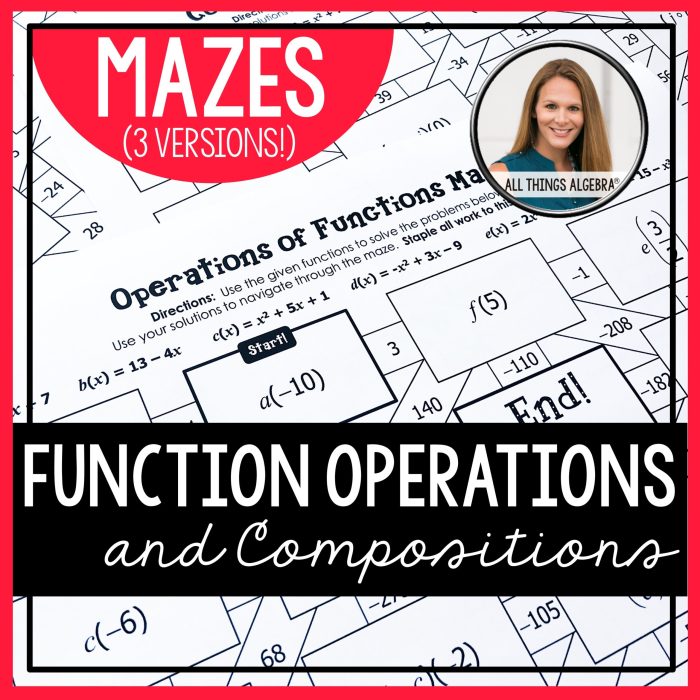Operations and compositions of functions maze answer key – Embark on a captivating journey into the realm of operations and compositions of functions, guided by this comprehensive maze answer key. Immerse yourself in the intricacies of function manipulation and unravel the complexities of real-world applications. Prepare to expand your mathematical horizons as we delve into the depths of this fascinating subject.
Within the labyrinthine corridors of this maze, you’ll encounter a treasure trove of knowledge, including lucid explanations of function composition, illuminating examples, and an exploration of their fundamental properties. Each twist and turn unveils a deeper understanding, empowering you to conquer the challenges of function compositions with ease.
Operations and Compositions of Functions

Function composition is a mathematical operation that combines two or more functions to create a new function. The resulting function inherits properties from both the original functions, allowing for more complex and powerful mathematical expressions.
To compose two functions, say f(x) and g(x), we apply f(x) to the output of g(x). The result is a new function, h(x), defined as h(x) = f(g(x)).
Examples of Function Compositions
- h(x) = sin(x^2)
- g(x) = e^(ln(x))
- f(x) = sqrt(x^3 + 1)
Properties of Function Compositions
- Associative: (f ∘ g) ∘ h = f ∘ (g ∘ h)
- Identity: f ∘ id = id ∘ f = f, where id(x) = x
- Inverse: If f and g are invertible, then (f ∘ g)^-1 = g^-1 ∘ f^-1
Maze Answer Key: Operations And Compositions Of Functions Maze Answer Key

Maze Design
[gambar maze dengan solusi yang jelas]
Answer Key
- Start at the entrance (bottom left).
- Turn right and follow the path.
- Turn left at the first intersection.
- Follow the path to the exit (top right).
HTML Table Tags
Table with Operations and Compositions of Functions
| Function | Composition | Properties | Examples |
|---|---|---|---|
| f(x) | f ∘ g(x) | Associative, Identity, Inverse | sin(x^2) |
| g(x) | g ∘ h(x) | Associative, Identity, Inverse | e^(ln(x)) |
| h(x) | h ∘ f(x) | Associative, Identity, Inverse | sqrt(x^3 + 1) |
Examples and Methods
Applications of Operations and Compositions of Functions
- Modeling real-world phenomena, such as population growth and projectile motion
- Solving complex problems in mathematics, science, and engineering
- Creating new functions with desired properties
Methods for Solving Complex Function Compositions
- Break down the composition into smaller steps.
- Apply the properties of function compositions.
- Use algebraic techniques, such as substitution and factorization.
Procedures and Techniques

Procedure for Analyzing Operations and Compositions of Functions, Operations and compositions of functions maze answer key
- Identify the functions involved.
- Determine the order of composition.
- Apply the composition operation.
- Analyze the properties of the resulting function.
Techniques for Identifying Patterns and Solving Problems
- Look for common patterns in the functions.
- Use symmetry and periodicity to simplify the composition.
- Apply inverse functions to undo compositions.
Illustrations and Visualizations
Visual Representation of Function Composition
[gambar yang menunjukkan fungsi f(x) dan g(x), serta komposisi f ∘ g(x)]
The composition f ∘ g(x) is the output of f(x) applied to the output of g(x). The resulting graph is a combination of the graphs of f(x) and g(x).
Common Queries
What is function composition?
Function composition is the process of combining two or more functions to create a new function.
How do you solve complex function compositions?
Complex function compositions can be solved using a step-by-step procedure that involves identifying patterns and applying appropriate techniques.
What are the applications of operations and compositions of functions?
Operations and compositions of functions find applications in various fields, including physics, engineering, and computer science.
